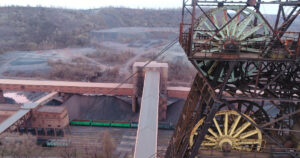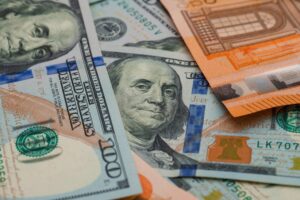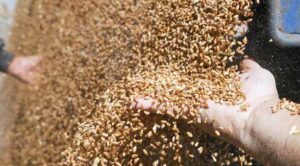
President of Ukraine Volodymyr Zelenskyy will visit the UAE and Saudi Arabia, but he will not meet with the Russians or the Americans.
“I have an official visit to the Emirates with my wife, the first lady, because we have a large humanitarian program, and the issue of prisoner exchange. Secondly, after that, I will visit Saudi Arabia with the same issues and another partnership with His Royal Highness. It will be for two or three days. I will have three meetings with President Erdogan in Turkey. I will not meet with the Russians, but I will not meet with the Americans there either,” Zelenskyy told reporters at the Munich Security Conference.

Sukha Balka Mine (Kryvyi Rih, Dnipro region), part of Aleksandr Yaroslavsky’s DCH Group, has launched a project to build a solar power plant at Frunze Mine.
As reported in DCH Steel’s corporate newspaper on Thursday, due to a constant shortage of generating capacity and restrictions on electricity consumption, the mine’s management decided to build its own power generation facilities.
“In June of this year, we plan to commission a power plant that will use an alternative source and provide electricity to Frunze mine. The power plant will have a capacity of 2 MW. While the design of the plant and the purchase of equipment are underway, construction has already begun at the mine,” said Igor Piltek, Deputy General Director and Chief Engineer of the mine.
According to him, a site for the installation of solar panels measuring about two hectares has already been prepared, and the surface has been planned. To build the power plant, it is necessary to install 2,740 solar panels.
The solar power plant will operate autonomously. According to forecasts, the equipment should pay for itself in four years.
Earlier, the Chief Engineer reported that energy-efficient projects are being implemented at the mine, in particular, the construction of a 2 MW solar power plant has begun, which is scheduled to be commissioned in the second quarter of 2025.
Sukha Balka mine is one of the leading mining companies in Ukraine. It produces iron ore by underground mining. The mine includes Yubileynaya and Frunze mines.
DCH Group acquired the mine from Evraz Group in May 2017.

Issue No. 1 – February 2025
The purpose of this review is to provide an analysis of the current situation on the Ukrainian foreign exchange market and a forecast of the hryvnia exchange rate against key currencies based on the latest data. We review current conditions, key influencing factors, and likely scenarios.
February 2025 started quite predictably for the Ukrainian FX market, without any sharp jumps or sudden shocks. After the traditional New Year’s Eve surge in demand for foreign currency, the market has gradually returned to a calmer state, and the hryvnia exchange rate continues to balance between domestic factors, such as the NBU’s policy and the country’s balance of payments, and global trends, such as the policies of the US Federal Reserve and the ECB.
The US Federal Reserve continues to keep interestrates high, strengthening the dollar, while the European Central Bank has cut interest rates, weakening the euro. This creates the preconditions for maintaining the current exchange rate dynamics, but also adds unpredictability for those planning currency transactions.
Analysis of the current situation
The hryvnia is gaining stability again
As predicted at the end of January, after the peak growth of the dollar (up to 42.28 UAH/$), the situation has gradually stabilized, and now the hryvnia is in the range of 41.37-42 UAH/$.
What contributed to this?
The situation is somewhat different for the euro. After the ECB unexpectedly cut interest rates in February, investors’ funds began to flow into the dollar en masse, which led to a weakening of the European currency. As a result, the euro exchange rate in Ukraine fell to the level of 43.2-43.9 UAH/€, and has been showing a steady downward trend for three months.
The market spread between the purchase and sale of key currencies has remained relatively stable for a long time: 50-58 kopecks for the dollar and 63-68 kopecks for the euro. This indicates a balance between supply and demand and can be considered both an indicator of the lack of appetite for speculation among currency market operators and an indicator of the absence of panic among the population.
Dollar exchange rate forecast
Short-term forecast (2-4 weeks)
The dollar exchange rate may fluctuate in the range of UAH 41.8-42.5/$. The NBU continues to actively restrain sharp fluctuations, as evidenced by the sale of foreign currency from reserves, and no major inflationary risks are expected in the coming month.
However, risks remain:
Medium-term forecast (2-4 months)
During the first half of the year, the hryvnia may gradually weaken to 44 UAH/$. Main reasons:
Long-term outlook (6+ months)
If the current macroeconomic picture persists, the dollar may reach 45 UAH/$ by the end of the year, although this scenario is entirely dependent on the success of the government’s economic policy and the stability and sufficiency of external financing inflows.
Euro exchange rate forecast
Short-term forecast (2-4 weeks)
The euro will be in the range of 43.0-44.2 UAH/€, with a gradual correction to the lower bound due to the euro’s weakness on the global market.
Medium-term forecast (2-4 months)
The euro may fall to 42.5 UAH/€ if the eurozone stagnation intensifies and the US Federal Reserve maintains its tight policy.
Long-term outlook (6+ months)
If the EU fails to recover from the economic downturn, the euro may remain weaker, allowing the hryvnia to maintain relative stability against it, and in some periods, the hryvnia may even strengthen against the euro.
Recommendations for businesses and investors
In the short term (up to 1 month), the main task is to ensure liquidity and minimize currency risks. Businesses should have a portion of their working capital in foreign currency, especially if their expenses depend on imports. Keeping funds in short-term deposits in US dollars or euros will help protect against exchange rate fluctuations. For private investors, now is not the best time to actively enter long positions in euros due to the weakness of the European currency, while the dollar remains a stable instrument. For those considering currency speculation, there may be opportunities to make money on short positions.
Medium-term strategies (2-4 months) should focus on building a balanced portfolio with a predominance of the dollar. As the US Federal Reserve is in no hurry to change its tight monetary policy, the dollar remains the most stable currency for capital preservation. Investors who want to diversify their portfolio should pay attention to assets in Swiss francs and British pounds, as they are less prone to strong fluctuations under the influence of geopolitical risks. Cryptocurrencies can be an interesting tool for short-term speculation, but they remain high-risk due to their high volatility.
In the long term (6+ months), the most important factor isto protect capital from devaluation risks. The main savings should be kept in hard currency, as even with a moderate devaluation trend, the hryvnia will continue to lose value. Alternative assets, such as gold, can be an effective means of preserving value, but the current high prices make it less attractive for immediate entry – it is worth waiting for a possible correction.
This material was prepared by the company’s analysts and reflects their expert, analytical professional judgment. The information presented in this review is for informational purposes only and cannot be considered a recommendation for action.
The Company and its analysts make no representations and assume no liability for any consequences arising from the use of this information. All information is provided “as is” without any additional guarantees of completeness, obligations of timeliness or updates or additions.
Users of this material should make their own risk assessments and informed decisions based on their own evaluation and analysis of the situation from various available sources that they consider to be sufficiently qualified. We recommend that you consult an independent financial advisor before making any investment decisions.
REFERENCE
KYT Group is an international multi-service product FinTech company that has been successfully operating in the non-banking financial services market for 16 years. One of the company’s flagship activities is currency exchange. KYT Group is one of the largest operators in this segment of the Ukrainian financial market, is among the largest taxpayers, and is one of the industry leaders in terms of asset growth and equity.
More than 90 branches in 16 major cities of Ukraine are located in convenient locations for customers and have modern equipment for the convenience, security and confidentiality of each transaction.
The company’s activities comply with the regulatory requirements of the NBU. KYT Group adheres to EU standards, having a branch in Poland and planning cross-border expansion to European countries.

Dnipro Metallurgical Plant (DMZ), a part of DCH Steel of businessman Aleksandr Yaroslavsky’s DCH group, cut rolled steel production by 64.2% year-on-year to 487 tons in January this year.
According to information in the corporate newspaper DCH Steel on Thursday, coke production in January 2025 decreased by 16.6% to 18.9 thousand tons, while in December 2024, 23 thousand tons were produced.
The company did not produce any steel products in December 2014, while in November it produced 7.1 thousand tons of rolled steel.
“In January-February, Rolling Shop No. 2 will produce 7.1 thousand tons of steel products during the rolling campaign. The campaign is scheduled to be completed by the end of the week. Last month, the plant shipped 948 tons of rolled metal products to consumers, including the volumes of Rolling Shop No. 1, and all the coke produced,” the information states, adding that the rolling campaign started on January 31.
As reported, in 2024, DMZ reduced its rolled steel production by 59.4% compared to 2023, to 42.9 thousand tons, and coke by 1.2%, to 289.1 thousand tons.
In 2023, DMZ increased its rolled steel output by 86.2% compared to 2022, to 105.6 thousand tons, and coke by 38.5%, to 292.7 thousand tons.
In 2022, the plant reduced its rolled steel production by 74.2% compared to 2021, to 58.4 thousand tons, and coke production by 56.3%, to 211.3 thousand tons.
DMZ specializes in the production of steel, pig iron, rolled products and products made from them.
On March 1, 2018, DCH Group signed an agreement to buy Dnipro Metallurgical Plant from Evraz.

In 2024, Agrotrade harvested more than 236 thsd tonnes of grains and oilseeds, the company’s press service reported on Facebook.
According to the report, the harvest of wheat amounted to 95.5 thousand tons, corn – 53 thousand tons, winter rapeseed – 38.3 thousand tons, sunflower – 36.6 thousand tons, soybeans – about 13 thousand tons, hemp – 96 tons, barley – 78 tons.
“This year, soybeans suffered the biggest yield losses, in particular, due to drought. In general, abnormal weather conditions affected all crops, but we are satisfied with the results of the season. Rapeseed and corn even outperformed the forecasts, while sunflower and wheat yields remained within the plan,” said Oleksandr Ovsyanyk, Director of Agrotrade’s Agricultural Department.
The agricultural holding is confident that due to effective management, adaptation of technologies and professionalism, it will be able to maintain stable positions in the agricultural market.
Agrotrade Group is a vertically integrated holding company with a full agro-industrial cycle (production, processing, storage and trade of agricultural products). It cultivates over 70 thousand hectares of land in Chernihiv, Sumy, Poltava and Kharkiv regions. Its main crops are sunflower, corn, winter wheat, soybeans and rapeseed. It has its own network of elevators with a one-time storage capacity of 570 thousand tons.
The group also produces hybrid seeds of corn and sunflower, barley, and winter wheat. In 2014, a seed plant with a capacity of 20 thousand tons of seeds per year was built on the basis of Kolos seed farm (Kharkiv region). In 2018, Agrotrade launched its own brand Agroseeds on the market.
The founder of Agrotrade is Vsevolod Kozhemiako.

In January 2025, Express Insurance (Kyiv) collected UAH 61.7 million in insurance premiums for voluntary motor insurance, which is UAH 14 million, or 29.2%, more than in 2024, the insurer’s website reports. In addition, according to the website, premiums for compulsory motor third-party liability insurance amounted to UAH 38.2 million, which is UAH 28.5 million, or almost four times more than in January 2024.
As for other types of insurance, the company collected UAH 2.7 million in January.
In total, in the first month of the year, the insurer collected UAH 102.6 million in premiums, which is 71.9% more than in January 2024.
In January, the company reportedly paid out more than UAH 34.4 million, which is 17% more than in the same period of 2024. In particular, payments under hull insurance amounted to UAH 27 million (+5.3%), under MTPL – UAH 6.8 million (2.4 times more), payments under other insurance contracts – UAH 660 thousand.
“The increase in MTPL payments is a direct result of customer confidence in the company and an increase in the number of contracts concluded,” the statement said.
Express Insurance ALC was founded in 2008 and is part of the UkrAVTO group of companies. The company specializes in automobile insurance. The consistently high speed of claims settlement in the IC is ensured by optimal interaction with partner service stations.
Since April 2012, Express Insurance has been an associate member of the Motor Transport Insurance Bureau of Ukraine.